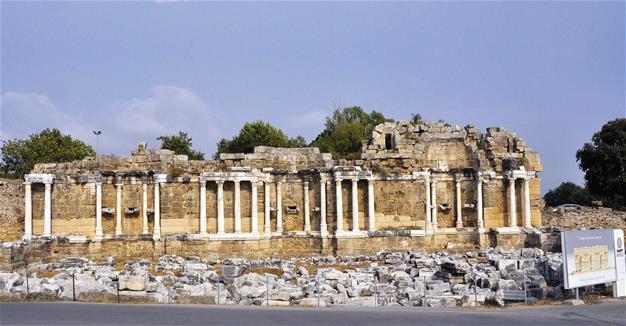Nymphaeum undergoing restoration in Antalya’s Side
ANTALYA

Restoration and conversation is set to start again at the Monumental Fountain (Nymphaeum) in the ancient city of Side in the southern province of Antalya’s Manavgat district.
The Monumental Fountain dates back to the 2nd century A.D. and has undergone a series of restorations since 2004.
Antalya Surveying and Monuments Director Cemil Karabayram, who recently visited the ancient site, said only 20 percent of the restoration has so far been completed, but the work will be finished in the coming period.
Karabayram said a financial allocation for the project had been provided under the auspices of Culture and Tourism Minister Professor Numan Kurtulmuş, Foreign Minister Mevlüt Çavuşoğlu and Antalya Governor Münir Karalıoğlu, and a tender will be initiated in the coming days.
He said there are a number of large stone blocks in the area, which have each been documented with a separate number, adding that the blocks and the arch structure at the front of the site will be placed on the upper columns.
12 million lirasKarabayram said the restoration team strongly suspects that new blocks will be found under the layer of soil right behind the fountain.
“Excavations will unearth these new blocks. I hope that we will make the fountain complete by finishing the work. Tourists will be able to enter the area and visit the fountain. Almost 12 million Turkish Liras have been allocated for the entire Side region and its monumental structures,” he added.
The restoration team plans to restore the pool system in front of the fountain to its original state, while the asphalt in the gate of the castle, which is located at the entrance of Side, will be removed.
Karabayram said the excavations at the ancient site of Side were first initiated by Professor Arif Müfit Mansel, whose words and articles about Side are very important.
“Mansel said a copy of this fountain was constructed in Italy by Italians. Of course this was a matter of debate but we are carrying out work for it. We are talking with art historians about this issue, and whether the fountain here was a source of inspiration for the fountain in Rome,” he added.
Karabayram also said some columns of the fountain have been preserved throughout history.
“All of these columns are original and new materials will never be used in the restoration. But some extra blocks could be placed in order to provide balance,” he added.
 Restoration and conversation is set to start again at the Monumental Fountain (Nymphaeum) in the ancient city of Side in the southern province of Antalya’s Manavgat district.
Restoration and conversation is set to start again at the Monumental Fountain (Nymphaeum) in the ancient city of Side in the southern province of Antalya’s Manavgat district.